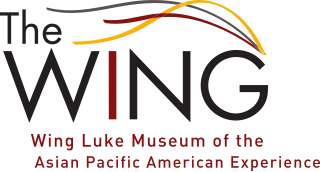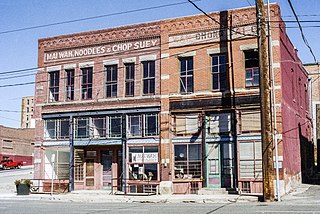
The Chinatown–International District of Seattle, Washington is the center of Seattle's Asian American community. Within the Chinatown International District are the three neighborhoods known as Chinatown, Japantown and Little Saigon, named for the concentration of businesses owned by people of Chinese, Japanese and Vietnamese descent, respectively. The geographic area also once included Seattle's Manilatown. The name Chinatown/International District was established by City Ordinance 119297 in 1999 as a result of the three neighborhoods' work and consensus on the Seattle Chinatown International District Urban Village Strategic Plan submitted to the City Council in December 1998. Like many other areas of Seattle, the neighborhood is multiethnic, but the majority of its residents are of Chinese ethnicity. It is one of eight historic neighborhoods recognized by the City of Seattle. CID has a mix of residences and businesses and is a tourist attraction for its ethnic Asian businesses and landmarks.

The Wah Mee massacre was a mass shooting that occurred during the night of February 18–19, 1983, in which Kwan Fai "Willie" Mak, Wai Chiu "Tony" Ng, and Keung Kin "Benjamin" Ng bound, robbed, and shot fourteen people in the Wah Mee gambling club at the Louisa Hotel in Chinatown-International District, Seattle. Thirteen of their victims died, but Wai Chin, a dealer at the Wah Mee, survived to testify against the three in the separate high-profile trials held in 1983 and 1985. It is the deadliest mass murder in Washington state history.

Chinatown is a neighbourhood in Vancouver, British Columbia, and is Canada's largest Chinatown. Centered around Pender Street, it is surrounded by Gastown to the north, the Downtown financial and central business districts to the west, the Georgia Viaduct and the False Creek inlet to the south, the Downtown Eastside and the remnant of old Japantown to the northeast, and the residential neighbourhood of Strathcona to the southeast.

The Wing Luke Museum of the Asian Pacific American Experience is a history museum in Seattle, Washington, United States, which focuses on the culture, art and history of Asian Pacific Americans. It is located in the city's Chinatown-International District. Established in 1967, the museum is a Smithsonian Institution affiliate and the only pan-Asian Pacific American community-based museum in the country. It has relocated twice since its founding, most recently to the East Kong Yick Building in 2008. In February 2013 it was recognized as one of two dozen affiliated areas of the U.S. National Park Service.
Tiong Bahru is a housing estate located within the Bukit Merah Planning Area, in the Central Region of Singapore. Tiong Bahru was constructed in the 1920s by the Singapore Improvement Trust, the predecessor to the Housing Development Board and an entity of the British colonial authority providing mass public housing in Singapore and is the oldest housing estate in Singapore. The main estate consists of 30 apartment blocks with over 900 units of two to five rooms that are also commonly referred to as "walk-ups". There are also high-rise Housing and Development Board (HDB) flats and condominiums along Boon Tiong Road, Jalan Membina and Kim Tian Road which surround the main estate.

Seattle is a charter city in the U.S. state of Washington with a mayor–council form of government. The Mayor of Seattle is head of the executive branch of city government, and the Seattle City Council, led by a Council President, is the legislative branch.

Petaling Street is a Chinatown located in Kuala Lumpur, Malaysia. The whole vicinity is also known as Chinatown KL. Haggling is a common sight here and the place is usually crowded with locals as well as tourists.

The Golden Dragon massacre was a gang-related shooting attack that took place on September 4, 1977, inside the Golden Dragon Restaurant at 822 Washington Street in Chinatown, San Francisco, California. The five perpetrators, members of the Joe Boys, a Chinese youth gang, were attempting to kill leaders of the Wah Ching, a rival Chinatown gang. The attack left five people dead and 11 others injured, none of whom were gang members. Seven perpetrators were later convicted and sentenced in connection with the murders. The massacre led to the establishment of the San Francisco Police Department's Asian Gang Task Force, credited with ending gang-related violence in Chinatown by 1983. The restaurant itself closed in 2006.

Wah Ching, meaning Chinese Youth, is a Chinese American criminal organization and street gang that was founded in San Francisco, California in 1964. The Wah Ching has been involved in crimes including narcotic sales, racketeering and gambling.

Hing Hay Park is a 0.64-acre (2,600 m2) public park in the Chinatown–International District neighborhood of downtown Seattle, Washington, United States. The park is located on the north side of South King Street between 6th and Maynard avenues, east of Union Station and the Historic Chinatown Gate. It was built in 1973 and includes a pavilion, community games, and two gateways.

Old Town Chinatown is the official Chinatown of the northwest section of Portland, Oregon. The Willamette River forms its eastern boundary, separating it from the Lloyd District and the Kerns and Buckman neighborhoods. It includes the Portland Skidmore/Old Town Historic District and the Portland New Chinatown/Japantown Historic District, which are listed on the National Register of Historic Places. It has been referred to as the "skid row" of Portland.

The Los Angeles Chinese massacre of 1871 was a racial massacre targeting Chinese immigrants in Los Angeles, California, United States that occurred on October 24, 1871. Approximately 500 white and Hispanic Americans attacked, harassed, robbed, and murdered the ethnic Chinese residents in what is today referred to as the old Chinatown neighborhood. The massacre took place on Calle de los Negros, also referred to as "Negro Alley". The mob gathered after hearing that a policeman and a rancher had been killed as a result of a conflict between rival tongs, the Nin Yung, and Hong Chow. As news of their death spread across the city, fueling rumors that the Chinese community "were killing whites wholesale", more men gathered around the boundaries of Negro Alley. A few 21st-century sources have described this as the largest mass lynching in American history.

The Mai Wah Museum is located in Butte, Montana, United States. Its mission is to document the history of Asian people in the Rocky Mountains. The museum is housed in the Wah Chong Tai building and Mai Wah Noodle Parlor building at 17 West Mercury Street.

Doyers Street is a 200-foot-long (61 m) street in the Chinatown neighborhood of Manhattan in New York City. It is one block long with a sharp bend in the middle. The street runs south and then southeast from Pell Street to the intersection of Bowery, Chatham Square, and Division Street. Doyers Street contains several restaurants, barber shops, and hair stylists, as well as the Chinatown branch of the United States Postal Service. The Nom Wah Tea Parlor opened at 13 Doyers Street in 1920, and is still in operation; other longstanding business include Ting's Gift Shop at 18 Doyers which opened in 1957.

Robert Stephen Lasnik is an American attorney and jurist, who serves as a senior United States district judge of the United States District Court for the Western District of Washington.
Crime rates in the state of Washington grew rapidly to large levels from 1960 to 1980, however slowed in growth from 1980 onward. Although the cause of this drop in crime growth from the 1980s cannot be directly determined, it was believed to have been a result from several law enforcement initiatives & policies implemented throughout the state of Washington and across the United States, such as abortion access.
The Joe Boys, or JBS, was a Chinese American youth gang founded in the 1960s in San Francisco's Chinatown. The Joe Boys were originally known as Joe Fong Boys, after its founder Joe Fong, a former member of the Wah Ching. Most of their members were born in Hong Kong or were of Hong Kongese descent.

Chinatowns are enclaves of Chinese people outside of China. The first Chinatown in the United States was San Francisco's Chinatown in 1848, and many other Chinatowns were established in the 19th century by the Chinese diaspora on the West Coast. By 1875, Chinatowns had emerged in eastern cities such as New York City, Boston, and Philadelphia. The Chinese Exclusion Act of 1882 barred Chinese immigration to the United States, but the Magnuson Act of 1943 repealed it, and the population of Chinatowns began to rise again. In the 2010s, the downturn in the U.S. economy caused many Chinese Americans to return to China.

Greater Seattle has had a Chinese American community almost since its founding in 1851. Chinese workers arriving in the 1860s were welcomed, because the Seattle area was sparsely settled and workers were needed; within a few decades, however, newly arrived white settlers resented the Chinese workers, and there were several anti-Chinese riots as the whites attempted to expel the Chinese from the area. Chinese settlement persisted, with the immigrants settling in a well-defined Chinatown where they maintained their culture through family groups, associations, and churches. In the mid-20th century Chinese Americans joined with other immigrant groups to oppose racial discrimination. In 1962 a Chinese American became the first person of Asian ancestry to hold elective office in the state of Washington.

The Boston Chinatown massacre or Tyler Street Massacre was a gang-related shooting in which five men were killed execution-style in a Boston Chinatown gambling den in the early morning hours of January 12, 1991. A sixth victim was seriously injured but survived. While no motive has been officially established, initial police reports and later FBI investigations indicated that the Ping On gang and one of the victims were vying for power in Boston Chinatown.



















